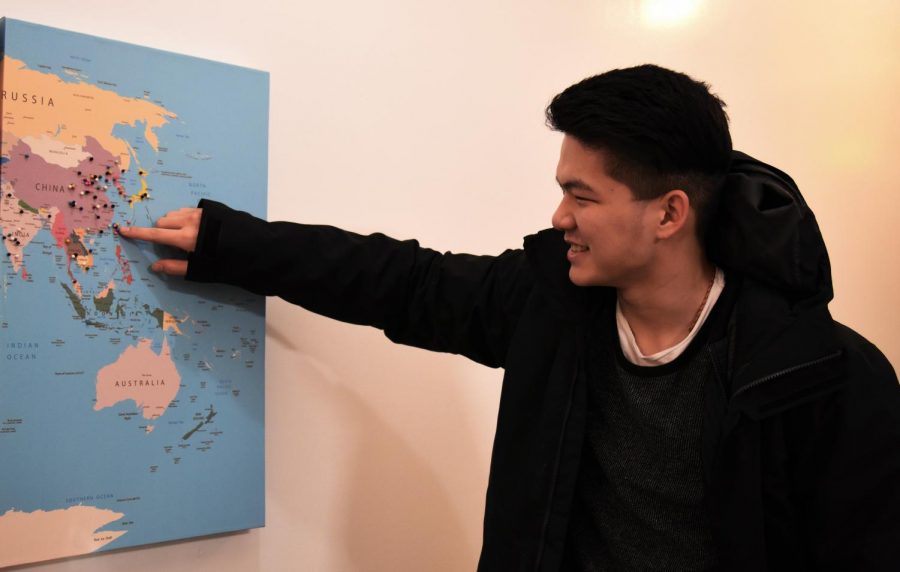WSU wants more international students
WSU bets on new recruits for revenue, research shows nationwide decline
LIHN NGUYEN | The Daily Evergreen
Sheng-Chieh “Jay” Kuo shows where Taiwan, his home, is in comparison to other students in the INTO program. This is his first year in the United States.
February 5, 2018
Despite a lower number of international students enrolling in universities nationwide, WSU still hopes to grow its international student enrollment through a recruitment and retention program called INTO.
According to a nationwide study of 500 colleges by the Institute of International Education, there are fewer international students enrolling in U.S. universities. Currently, about 7 percent of the WSU student population on campus is made up of international students.
Led by International Programs Vice President Asif Chaudhry, INTO is a collaboration between the Office of International Programs and the Office of the Provost.
Through INTO’s partner program, the Intensive American Language Center, Sheng-Chieh “Jay” Kuo is currently learning English to prepare him for his college career at WSU. Kuo is a sophomore planning to study business and marketing and is in his first year of living in the U.S.
“I chose the program to study English,” Kuo said. “It’s more about studying. You need to apply yourself to meet [requirements].”
Kate Hellmann, academic director of the Intensive American Learning Center, said International Admission officers select students for the INTO program based upon the criteria within their admissions papers. She said the program is designed to help international students succeed during their time at WSU.
The INTO program provides pathways, she said, which are a combination of English language courses as well as classes designed to keep non-native English speakers in mind.
Pathways are typically two semesters where students pay for services to accommodate their academic and extracurricular needs.
Kuo said the program is categorized into levels, depending on a student’s English proficiency. For undergraduate students, he said, there are five levels within a pathway. However, graduate students are allowed six levels of the pathway to better prepare them for their graduate studies.
There are currently 236 students in the entire INTO program, with 10 students in Kuo’s level of classes.
Hellmann said on average, 85 percent of the students enrolled in the INTO program passed or progressed. This means they either advanced into another level of English, moved on to another semester of a pathway or moved out from the program and transitioned into typical college classes.
Through the admissions process, Kuo was initially enrolled in level two, where he watched short videos in English, had timed writes, weekly grammar tests and official speaking tests.
This semester, Kuo progressed from level two and is currently enrolled in level three of the INTO program.
Here, his classes are similar, but all the homework is extended. Kuo said his videos went from being 2-3 minutes to 5-6 minutes long. Level three is also much more focused on grammar and listening, which is more difficult, said Kuo.
Kuo said he pays a little more than 1 million New Taiwan Dollars for all his expenses at WSU, which is about $34,000 in U.S. dollars. International students on average pay about $17,000 more in tuition and fees than domestic students and pay about $2,000 more than out-of-state students.
Although enrolling in the program was an extra expense, Kuo said it has drastically improved his English skills.
“I talked to people in the U.S. and say ‘I’m sorry my English is not well,’ but they say it’s OK,” Kuo said.
Although Taiwan has many opportunities to learn English, Kuo spent most of his years studying and performing acrobatics. As this took up most of his time, he never had the opportunity to properly attend English classes.
“I rarely speak English in my own country,” Kuo said. “I just speak Chinese.”
He was not formally recruited by WSU’s admission team. Instead, he attended a cram school in Taiwan, which are specialized schools to help students get accepted into high schools or universities. WSU was one of the schools on a list of American universities Kuo qualified for.
WSU also recruits international students through professional recruiters who help students learn about the application process at WSU. They provide information on tuition costs and fees, as well as administer an official test for students to measure their English proficiency.
By offering an environment for international students to be treated like any WSU student on campus, Hellmann said that the INTO program partnership would hopefully increase the enrollment of international students.
“The internationalization of WSU is really enriching the experience of all students,” Hellman said.
Correction: There are 236 students enrolled in the INTO program, not 80.















